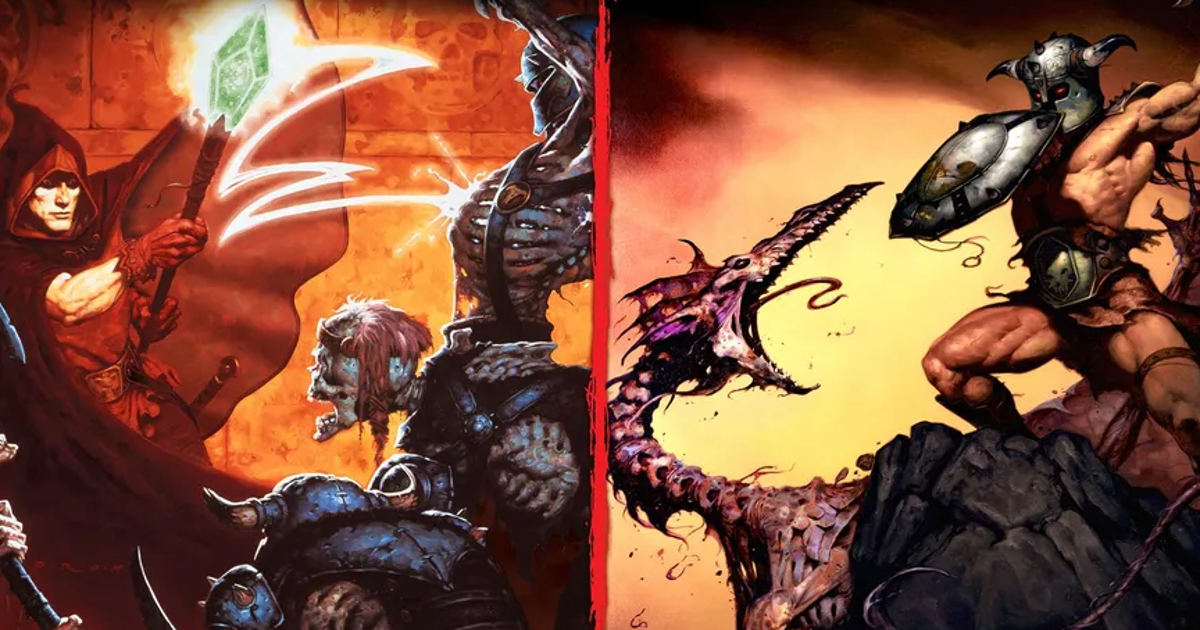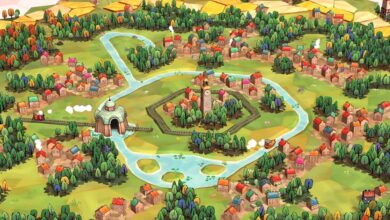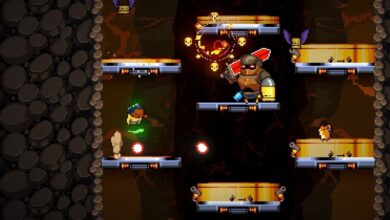Heretic + Hexen isn’t Nightdive’s most essential remaster but it is perhaps its most fascinating, and makes for a cracking portal into retro FPS history

August is the new Christmas for gen Xers and elder-millennials who go all misty eyed upon hearing the word “gibs”. Nightdive’s annual remaster of an FPS classic has become as much a QuakeCon tradition as judging who’s got the filthiest keyboard, the one present guaranteed to be under the event’s dripping, corpse-festooned tree.
Honestly though, it snuck up on me this year. With the first two Dooms and both original Quakes revived, remastered, and expanded, what heroes of yore remain in id and Bethesda’s sepulchral archive to resurrect? Nightdive responds to this by breaking down the door dual-wielding its most intriguing offering yet: Raven Software’s fantasy Doom clone Heretic and its peculiar, peregrinating cousin Hexen.
Both games receive the same treatment as those aforementioned FPS titans – a technical overhaul, a rerecorded soundtrack, full mod support and a new episode for both games. But the challenge here is different. Nobody needed convincing to replay Doom or Quake; the onus was instead on doing those undisputed classics justice. But Heretic and Hexen don’t have the same reputation. The former is basically Doom wearing a dressing gown, while the latter is an intriguing experiment in FPS level design many would argue failed. Even in Nightdive’s care, can these two hastily-conjured products of mid-90s Doom-mania really hold up in 2025?
Heretic-ing a lot of boxes…
The short answer is yes, albeit to different extents and for different reasons. We’ll start with Heretic, wherein elf-mage Corvus embarks on a meandering quest to defeat the sorcerous serpent rider D’Sparil. Heretic follows Doom’s template closely, but paints in even bolder colours than id Software’s 1993 masterpiece. It also sprinkles a few new ideas on top of id Software’s design, such as the ability to look up and down, and a simple inventory system where you can select and use certain items you’ve picked up on demand.
The first of these is immediately improved by Nightdive’s remaster, reworked into proper free-look that works just like a 3D shooter. It still doesn’t feel wholly natural due to how the geometry shifts around when you look up. But from a practical perspective it’s a whole lot more convenient.
Coupled with a framerate boost to 120FPS, Heretic’s spell-slinging is both wondrously smooth and deliriously fast. This has a compound effect on the game’s levels, which are generally larger and more complex than those seen in Doom. While wonderfully designed for the most part, with more recognisable buildings and environments than Doom, navigating these could be quite exhausting in the original. But now they clip along at a much healthier pace.

Outside of giving you a bunch of new spaces to explore, Heretic mainly justifies its existence in two ways. The first is its weapons, which are clever and colourful reimaginings of Doom’s arsenal. The Ethereal Crossbow’s green-arrow scattershot is a fun fantasy equivalent to Doom’s shotgun, while the Hellstaff’s crimson death-ray cleverly reuses the plasma guns’s lock-on chain fire. Admittedly, the firemace still kinda sucks. But let’s face it, it wouldn’t be Heretic if it didn’t.
But what makes Heretic’s arsenal special are its alternate modes. Rather than a modern-alt fire, these are unleashed by activating one of the items you can pick up – the Tome of Power. With this activated, the hellstaff spawns scarlet clouds that rain bloody hell on your enemies, while the Phoenix Rod, which is basically a rocket launcher by default, instead unfolds a tongue of flame that lashes your enemies to death.
I’m also extremely fond of Heretic’s enemies, which are arguably even more fun to squish and splatter than Doom’s demonic menagerie. There are dozens of delightful demises here, from the way D’Sparil’s arcane disciples explode in a flash of viscous pink energy, and the mummies that crumble into purplish dust.

The highlight, though, are undoubtedly the golems. When killed, they burst in an extraordinary fountain of pixellated flesh, before their skeletal soul ascends from the remains, screeching as it departs the material plain. I can just imagine Raven’s designers breathlessly discussing this idea: “Dude, what if his f***ing ghost came out?” It’s a detail that makes the golems endlessly fun to murder, and you can see how Raven went on to make Soldier of Fortune in the noughties.
The new episode by Nightdive – Faith Renewed, is basically an ode to Heretic’s sorcerous extravagance. It further clarifies the original’s vision of depicting early 3D levels as more coherent spaces. Framing this new adventure as a step-by-step assault on a city dominated by a hulking citadel called the Grand Chapel, it sees you fight through the city’s outskirts, breach the main gate, then battle through a subterranean prison and a vast, lava-filled forge in preparation for the climactic encounter.
Among all this are two standout levels. The first is the Crimson Palace. This is primarily distinguished by its colour-pallete – a warren of scarlet halls and ruby corridors that looks unlike anything else in the episode. But it’s also the point at which the full potential of your arsenal is unlocked, and as such when the challenge begins to ramp up. It’s filled with gnarly ambushes, deviously placed enemies, and a great moment where a horde of foes bursts through a stained-glass window.



The other is the Eye of D’Sparil, an enormous temple complex which serves as the episode’s penultimate level. Seeing this for the first time, you’ll wonder how the heck you’re supposed to complete it, which makes unpicking the order of its many nightmarish outbuildings all the more gratifying.
Navigating the Eye of D’Sparil pumps you up for that climactic assault on the grand chapel. This makes it a bit of a shame that the final level transports you straight to the boss encounter. This is fairly typical for Doom-style. But the chapel looks so vast and imposing on the overworld map that it’s a shame you don’t really get to explore it.
Nonetheless, Heretic and its new episode are an easy recommend. Things are a little more complicated for Hexen, which despite sharing the same theme and engine as Heretic is a very different prospect. To summarise, Heretic is wholly unashamed of its Doom lineage, whereas Hexen does everything it can to separate itself from the DNA of id Software.

…but also Hexen our bets (sorry)
This is most obvious in the level design, which I’ll discuss shortly. But it’s abundantly clear in the presentation too. Heretic’s fantasy world feels like it was channelled directly from the runaway imaginations of its designers, all gaudy colours and motley enemy types designed with almost childish energy and glee. Hexen’s art, by comparison, was designed amid vast stacks of sword and sorcery novels. It’s dark, autumnal world is far more artistically consistent than Heretic, while also being populated by the most swole enemies ever committed to code. Everything in Hexen has a six pack. The centaurs. The snake guys. The flying imps. Even the swamp monsters have been doing more crunches than your average triple-A game developer.

Beyond its hench mermen, Hexen’s biggest divergence from Heretic is how it tries to infuse the pace of an FPS with the roleplaying elements of a dungeon crawler. Rather than play an assigned character, you get to pick from three fantasy archetypes – fighter, cleric and mage. Meanwhile, each episode is built not as a linear sequence of levels, but as a complex hub-and-spoke design connected by one long environmental puzzle.
Historically, this approach has proved divisive, and the scars of that scepticism are written into Nightdive’s remaster, with literal arrows etched into the floors of some rooms to aid navigation. Personally, I find this element of Hexen to be hugely rewarding. I enjoy how these elaborate hubs gradually unfold as you master them. This is often literally the case, with the 3D geometry transforming around you as you explore. Cavern walls shifting, floors crumbling, stairs rising from the ground. Given the limitation of the tech Raven was working with, the environments are astonishingly dynamic.

In a post Dark Souls world, there’s greater tolerance for this kind of gnomic design, and it wouldn’t surprise me if Hexen’s navigational puzzles were reevaluated in the wake of this remaster. That said, Hexen is undoubtedly an inferior shooter to Heretic. Its quality depends somewhat on which class you choose, with the mage offering the most consistently enjoyable arsenal. But in all instances, you have fewer options at your disposal, while the fighter and cleric are burdened with a heavier emphasis on melee fighting which simply doesn’t hold up. Enemy death animations are just as darkly creative as Heretic, but there are only so many times you can feebly rub Timon’s axe up against those two-headed dogs before your snoring head smacks into the keyboard.
As for Hexen’s new episode, the aptly named Vestiges of Glory, it aims to validate the idea behind its hub-based levels, using the same crisscrossing, puzzle-based design, but smoothing out some of the more obscure navigational challenges of the original. This element certainly works, and Vestiges of Glory sees the benefit of 30 years of accrued level design knowhow. But it also aims to increase the combat challenge with more heavily populated environments, which makes the rudimentary melee combat even more exhausting.

All told, both new episodes are thoroughly entertaining. They’re not as distinctive as the additional episodes previously made for Doom, Quake and Quake 2, but that may be a consequence of having to do two extra episodes rather than one. Also, Hexen’s unusual structure makes it especially challenging to replicate, so the fact Vestiges of Glory works is an achievement in and of itself.
Heretic and Hexen were never essential entries in the FPS Hall of Fame, and Nightdive’s overhaul doesn’t change that. But they are fascinating tangents in the story of the first-person shooter, and the remaster makes it far easier to appreciate how they each responded to the radical shift in the gaming landscape caused by Doom. Most importantly though, these games remind us that the virtual enemies we so mindlessly massacre have souls too, and it’s way more fun when you see them escape after juicing their bodies like an orange.



